
Yeah, it’s easy to make fun of Monogram Pictures. Hell, I’ve been doing it since I was 12 years old — and that’s close to a hundred years when you factor in daylight savings time and leap years. All the same, did Jean-Luc Godard dedicate Breathless (1960) to MGM or Paramount? No, he did not. He dedicated that cornerstone of New Wave cinema to Monogram. Frivolous? Maybe. A joke? Well, Godard’s never struck me as being a firkin of simians, so I doubt it. Was he thinking of King of the Zombies (1941) and Bowery at Midnight (1942)? Probably not, but you can’t prove it. It would make me like the man better if he did, so I’m giving him the benefit of the doubt and assuming that maybe he’s a closet Bela Lugosi and Mantan Moreland fan. I’m certainly a fan, but I’m not hiding the fact. Indeed, I revel in my admiration for the two. My only regret is that they never appeared together — though not for want of trying, since it appears that King of the Zombies was originally meant to be a Bela Lugosi picture, but timing intervened. It is one of the great tragedies of film. Well, maybe not, but it would have been mighty nice, though one wonders if he would have balked at wearing the mask for the voodoo ceremony—the one that makes the character look rather like a giant pickle.
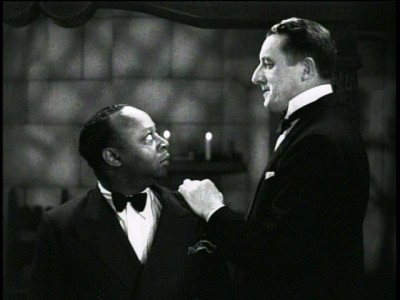
The story goes that the film was written and designed with Lugosi in mind for the villainous Dr. Sangre. It certainly has all the earmarks of a Lugosi role — a creepy foreigner with a zombie-like wife (Patricia Stacey), a sinister, isolated castle, equally sinister servants and a small squad of zombies. If those aspects sound like Lugosi’s White Zombie (1932), that’s probably far from accidental. White Zombie was still the only real template for the zombie sub-genre at that time. And what of the low-rent, fourth-billed (rightly) actor — Henry Victor — taking on the Lugosi honors? Well, even though Victor was English, he was raised in Germany, so the accent is genuine, but here he goes — or was directed to go — for the famous Lugosi pause. You know, the way he says things like, “I never drink…wine,” or “I have chartered a ship to take us to England. We will be leaving…tomorrow…evening.” When Lugosi does it, it’s eerie, otherworldly, hypnotic. When Victor says, “How about a little wine…to warm you up,” or, “He won’t…hurt you if he…likes you,” it just sounds like someone having trouble remembering his lines.
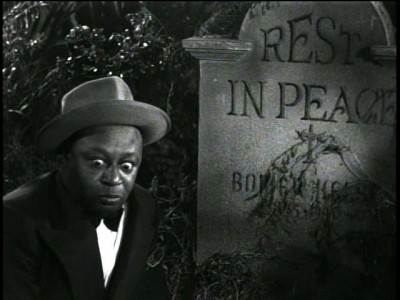
Hobbled though it is by an uninspiring bad guy, the clue to the film’s enduring appeal lies in the layout of its main title credit, which duly lists obnoxious leading man Dick Purcell and damsel in distress Joan Woodbury, but then — on a separate line and in bigger type — we have “Mantan Moreland.” He’s really the show — and the studio knew it. They also knew his presence — prominently displayed — meant solid business in Harlem and other predominately black communities where he was very popular. It meant something else, too. It meant that Moreland would take their threadbare script and punch it up with additional bits of business and nonstop ad-libs that were actually funny. Yeah, he’d still be playing the scared black servant, but he’d play it like a guy who knew what he was playing — and wasn’t taking it seriously. Moreland might go through the motions of playing the stock stereotypical character, but all the while he was cracking wise at his employers and making sport of the movie he found himself in — as witness his assessment of the sound of voodoo drums with, “I don’t know, but it ain’t Gene Krupa.” And I’ve been getting the good out of his excuse for being a chatty “zombie” — “Can I help it that I’m loquacious?” — for years now. (It’s an excellent riposte to editors complaining about the length of your writing.) Really, it’s Moreland that makes this movie.

Truth to tell, King of the Zombies is an unusually elaborate — elaborate being a relative term here — production for Monogram. The sets are actually solid-looking and atmospherically lit (as opposed to merely under-lit, as was often the case). And the musical score by Edward Kay is more ambitious than the studio’s usual use of library tracks. Whether or not it really deserved that Academy Award nomination it got (no, I’m not kidding) is another matter. The story, of course, is beyond preposterous with its Nazi agent (never identified as such, but it’s obvious) mad doctor attempting to use voodoo rituals to get secret information. But then, that’s part of the charm of these movies — the feeling that they were written by precocious (but demented) 12-year-olds, with all the logic that suggests.
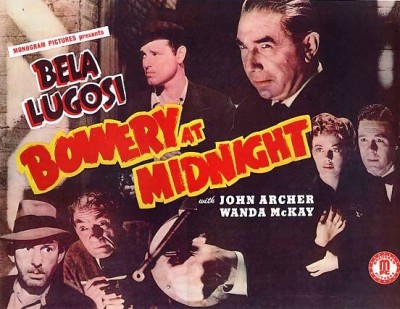
There’s certainly no sign of logic in Wallace Fox’s Bowery at Midnight (1942), the fifth of Bela Lugosi’s notorious “Monogram Nine.” Here we have one of the most peculiar mishmashes of genres imaginable. Lugosi plays a fussy, pince-nez-wearing college professor by day, who spends his evenings running the Friendly Mission in the Bowery. Ah, but you see, this is merely a front for his decidedly economical empire of crime. His constantly revolving crew of henchmen (he’s prone to bumping them off and burying them in his Arsenic and Old Lace-style basement cemetery) never seems to number more than two. Well, there’s also Doc Brooks (Lew Kelly), a drug-addled “human derelict,” whose actual function is unclear — until he turns out to be a kind of mad doctor ex machina at the very end. (The drug addict angle is surprisingly upfront.) Chief among its delights — apart from the immortal Lugosi line, “Doc, how many times have I told you to keep that cat from desecrating my graves?” — is the fact that Bela not only has a secret room, but the damned secret room has its own secret room (mystifyingly located under a map of Australia).
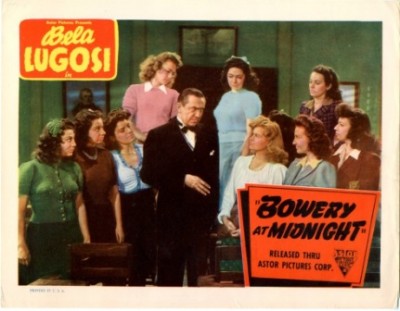
Bowery at Midnight is actually considered to be one of Lugosi’s better Monogrammers — again, that’s a relative term. I’m not sure why exactly. It certainly makes no more sense than any of the others. Granted, it does have a slightly disturbing offhand cold-bloodedness to its violence, but it’s mostly just screwy fun. Sharp-eyed viewers will spot (along with the shadow of the boom mike) the poster for Bela’s previous big Monogram hit, The Corpse Vanishes (also 1942), on a theater in a tracking shot with Dave O’Brien and George Eldredge walking along the street. The most unfortunate thing about the movie is that neither the image of Lugosi brandishing a machine gun, nor that of him “menacing” a bevy of co-eds in his classroom actually appear in the film, despite being used in the advertising. Ah, well.
The Thursday Horror Picture Show will screen King of the Zombies and Bowery at Midnight Thursday, Dec. 6 at 8 p.m. in the Cinema Lounge of The Carolina Asheville and will be hosted by Xpress movie critics Ken Hanke and Justin Souther.


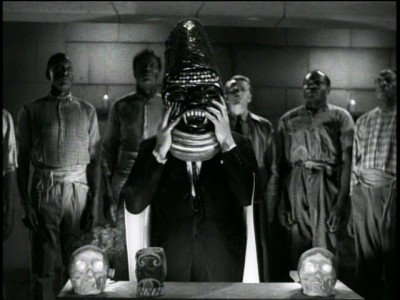
Before you comment
The comments section is here to provide a platform for civil dialogue on the issues we face together as a local community. Xpress is committed to offering this platform for all voices, but when the tone of the discussion gets nasty or strays off topic, we believe many people choose not to participate. Xpress editors are determined to moderate comments to ensure a constructive interchange is maintained. All comments judged not to be in keeping with the spirit of civil discourse will be removed and repeat violators will be banned. See here for our terms of service. Thank you for being part of this effort to promote respectful discussion.